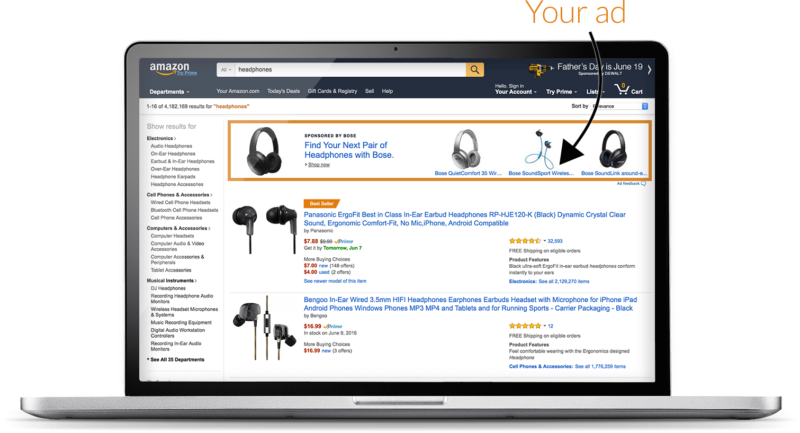 Amazon used to just do books, but now they do more or less everything. Aside from every imaginable retail product, they also provide video, groceries, music and cloud computing, and they’ve even opened a few physical bookstores. It was just a matter of time before they launched an advertising platform as well.
Amazon used to just do books, but now they do more or less everything. Aside from every imaginable retail product, they also provide video, groceries, music and cloud computing, and they’ve even opened a few physical bookstores. It was just a matter of time before they launched an advertising platform as well.
For US readers, that’s pretty old news by now. For the UK and Europe, the launch of Amazon Marketing Services (AMS) is much more recent.
Still, despite AMS having been around for a while, I haven’t seen many articles or advertising professionals talking about it. I am going to switch gears here, and instead of talking about Adwords or pay-per-click (PPC) issues like I normally do, I’m going to share my insights on Amazon Marketing Services.
PPC and AMS aren’t so different
In my opinion, Amazon Marketing Services is nowhere near as good as AdWords.
While AdWords has the advantage of being an older, more well-known program, there are a number of important similarities between them:
- They are both keyword-driven.
- They both have an application program interface (API) (the AMS is not as accessible).
- They both have flaws/limitations, and therefore, opportunities for innovation.
- They both want to push their automatic-campaign option.
If you have been using AdWords for some time, you will have a strong foundation for AMS.

A manual approach is best in AMS
I believe both Amazon and Google want to make an advertising platform that doesn’t need a media agency or an expert in-house team to successfully manage it, not because they hate media agencies (I don’t think), but because that lowers the barriers to entry. The automated campaigns are much easier to set up, meaning that lack of experience isn’t a deterrent to using these features. This is in Amazon/Google’s advantage, as it leads to more customers 🙂
In my opinion, dynamic search ads (DSAs) suck, and Amazon’s automated campaigns are merely adequate in comparison to what can be achieved with a manual build. That’s not to say you shouldn’t use Amazon’s automated mode when beginning a new campaign. In fact, you definitely should do it to help build up your keyword knowledge.
Use Automatic Targeting to research the best-performing keywords. Then funnel from using broad match to exact match keywords. After enough activity, move to exact match only, with automatic capturing the remaining inventory.
Getting the level of granularity right
In AMS, the Amazon recommendation is one campaign per product. Now, I’m a huge advocate of granularity — hence using the single-keyword-per-ad-group structure in PPC builds — but for large retailers, Amazon’s recommended structure simply isn’t feasible.
The argument is that Amazon recommends too much granularity, and in principle, granularity is normally good, as it enables greater control over your account.
For example, in PPC, a single keyword per ad group structure means you can adapt an account at keyword level. However, due to the lack of maturity in AMS, it’s not feasible to manage the potentially tens of thousands of campaigns a manual build might encompass for a midsize to large retail company.
To properly split things out, it wouldn’t just be one campaign per product. Instead, for each product, they recommend using:
- Headline Search — banner ads above search results.
- Sponsored Product — automatic targeting/manual targeting (ads alongside organic search results).
- Product Display — ads appearing on related product pages.
Then, within those ad types, you will need separate brand, generic and competitor campaigns. This makes a total of 12 campaigns per product! If you’re a retailer with thousands of products, it’s not going to work.
Rather than individual products, create campaigns for product types then build product categories and ad types to fall under them. Like this:

This makes the number of campaigns more practical for account management and optimization.
Reporting, testing, optimizing
With AMS, you can’t do any of these things to the same degree that you can in AdWords, but that should improve over time.
Still, the same principles apply: Automate reporting, test continuously and optimize continuously by comparing manual and automated Sponsored Product campaigns or just comparing a range of product types.
With a good measurement strategy in place, it’s easy to A/B test a whole range of variations for ad types, audience targeting, bidding strategies and products.
After studying a few retail sites, we’ve quickly been able to identify differences in performance between product types, leading to great improvements in budget optimization.
Likewise with ad types. There are huge rewards in AMS, as with AdWords or a platform like Facebook Business, to being proactive in making continual improvements, which means that anyone who loves data and automation is going to thrive here.
Current issues with AMS (and potential future solutions)
The big issue is budget. Daily budget is spent in “Accelerated Delivery” mode (after all, this IS Amazon), which means it will often run out before midday; therefore, some of the best traffic might be missed.
Accelerated Delivery mode and Standard Delivery mode are terms taken from AdWords but are applicable to AMS, too. In standard mode, the algorithm is designed to spread the budget across the entire day; in accelerated mode, the algorithm is optimizing for ensuring that the entire budget is spent, which often leads to all of it being used halfway through the day. When this happens, you could miss out on potentially valuable traffic later in the day.
Data reporting in AMA has 90 days’ visibility, then it’s lifetime after that, which is a bit lame. An automated weekly, monthly and yearly reporting dashboard would be an easy fix for this.
Setting up an account is extremely slow and painful; a bulk submitter for campaign creations would be helpful. The User Interface (UI) has limited functionality and optimization opportunities, however, it does have an API, so there is hope for customizations.
Again, this is Amazon, so expect exponential improvement as its supply of data increases.
Conclusion
This gives you a general overview of Amazon Market Services. AdWords is still my PPC superhero, but there are always early-bird advantages in digital media, so let’s pioneer together to take AMS to the next level!
Contributing authors are invited to create content for Search Engine Land and are chosen for their expertise and contribution to the search community. Our contributors work under the oversight of the editorial staff and contributions are checked for quality and relevance to our readers. The opinions they express are their own.



